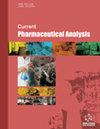Determination of Diphenidol in Mouse Plasma and Application to a Pharmacokinetic Study Using Uplc-Ms/Ms
IF 1.5
4区 医学
Q4 PHARMACOLOGY & PHARMACY
引用次数: 0
Abstract
Objective: Difenidol is widely used in clinical practice due to its good anti-dizziness effect and low side effect rate. This aim was to develop an ultra-high performance liquid chromatography- tandem mass spectrometry (UPLC-MS/MS) method for the selective and straightforward measurement of diphenidol in mouse plasma. Methods: A total of eighteen mice were divided into three groups: six for intravenous administration at a dose of 0.2 mg/kg, six for oral administration at a dose of 0.4 mg/kg, and another six for oral administration at a dose of 1.6 mg/kg. The analytes were extracted using acetonitrile-mediated protein precipitation following the addition of the internal standard (IS), midazolam. On an Acquity HSS T3 column (50 mm × 2.1 mm, 1.8 μm). The quantification process involved the use of multiple reactions monitoring (MRM) mode, with target fragment ions m/z 310.2→128.9 for diphenidol and m/z 326.2→291.4 for IS. Results: For diphenidol, calibration curves showed a linear distribution between 0.2 and 50 ng/mL. The accuracy of the method was between 94.6% and 110.4%, and the mean recovery of diphenidol in mouse plasma was over 76.5%. The intra-day and inter-day precision RSDs were both limited to 14%. The bioavailability of diphenidol in mice was determined to be 19.9% and 23.56% for the oral dose of 0.4 mg/kg and 1.6 mg/kg, respectively. Conclusion: The UPLC-MS/MS was successfully applied to study the pharmacokinetics of diphenidol in mice, to which it was administered orally and intravenously.使用 Uplc-Ms/Ms 测定小鼠血浆中的地芬尼多及其在药代动力学研究中的应用
目的:地芬尼多(Difenidol)具有良好的抗头晕效果和较低的副作用,被广泛应用于临床。本研究旨在建立一种超高效液相色谱-串联质谱(UPLC-MS/MS)方法,用于选择性地直接测定小鼠血浆中的地芬尼多。方法:将 18 只小鼠分为三组:6 只静脉注射,剂量为 0.2 毫克/千克;6 只口服,剂量为 0.4 毫克/千克;6 只口服,剂量为 1.6 毫克/千克。在加入内标(IS)咪达唑仑后,使用乙腈介导的蛋白质沉淀法提取分析物。采用 Acquity HSS T3 色谱柱(50 毫米 × 2.1 毫米,1.8 微米)。定量过程采用多反应监测(MRM)模式,目标碎片离子 m/z 310.2→128.9 表示苯海索,m/z 326.2→291.4 表示内标。结果:苯海索的校准曲线在 0.2 至 50 纳克/毫升之间呈线性分布。方法的准确度为94.6%~110.4%,小鼠血浆中的苯海拉明的平均回收率超过76.5%。日内和日间精密度RSD均不超过14%。小鼠口服 0.4 毫克/千克和 1.6 毫克/千克剂量时,苯海拉明的生物利用度分别为 19.9% 和 23.56%。结论UPLC-MS/MS 成功地应用于研究小鼠口服和静脉注射苯海拉明的药代动力学。
本文章由计算机程序翻译,如有差异,请以英文原文为准。
求助全文
约1分钟内获得全文
求助全文
来源期刊
CiteScore
1.50
自引率
0.00%
发文量
85
审稿时长
3 months
期刊介绍:
Aims & Scope
Current Pharmaceutical Analysis publishes expert reviews and original research articles on all the most recent advances in pharmaceutical and biomedical analysis. All aspects of the field are represented including drug analysis, analytical methodology and instrumentation. The journal is essential to all involved in pharmaceutical, biochemical and clinical analysis.

 求助内容:
求助内容: 应助结果提醒方式:
应助结果提醒方式:


